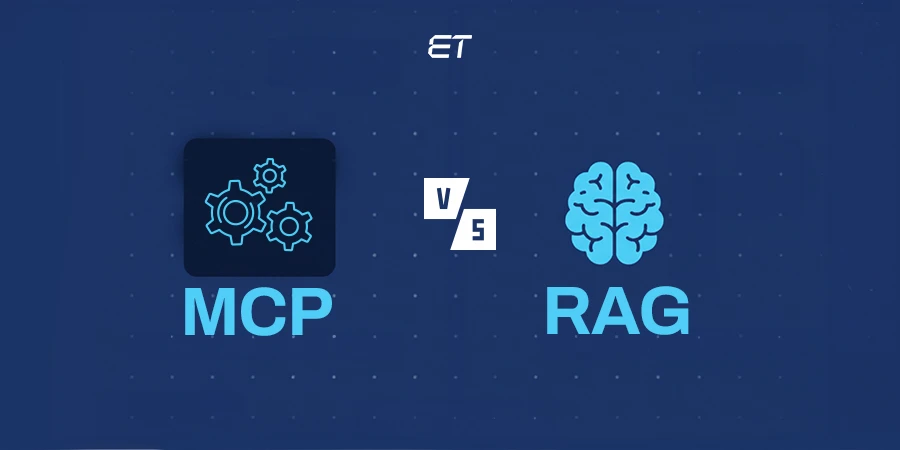
Why Ambient Intelligence Is Impossible to Ignore?
- Ambient Intelligence (AmI) takes AI beyond commands, enabling systems to sense, analyze, and act autonomously.
- By integrating AI, IoT, big data, and edge computing, AmI creates smarter, self-optimizing environments.
- Industries use AmI for predictive maintenance, automation, energy efficiency, and enhanced security.
- Adopting AmI ensures you stay ahead in an AI-driven world.
Even if you have all the correct data, it’s possible that critical insights slip away. In such cases, human intervention becomes vital. What if you use Ambient Intelligence (AmI) to solve this problem?
Well, if you do, this tech will understand your business environment and adapt without waiting for your command. With 97% of enterprises investing in AI, you need to be one step ahead. By using AmI, you can shift from smart AI to aware AI.
But the main question is – do you know this concept in depth? If the answer is no, this blog can help put forth your next strategic investment. So, scroll ahead to get all the crucial details on Ambient Intelligence in AI.
Looking for experts who can help adopt AmI? End your search now!
What is Ambient Intelligence?

Think of Ambient Intelligence (AmI) as the next generation of AI.
So far, you must be aware that AI responds to your commands. For example, ChatGPT gives apt responses after you enter a prompt.
However, AmI doesn’t wait for your input. It observes, analyzes, and acts autonomously to improve efficiency and decision-making. Basically, AmI combines the following facets:
- Artificial intelligence
- Internet of Things (IoT)
- Big data
- Edge computing
The end result?
You get systems that are more aware of their surroundings. Let’s explain this concept with a couple of hypothetical examples:
- An office space where lights, temperature, and security systems adjust based on employee presence.
- A manufacturing unit where machines predict failures before they happen without human intervention.
Today, the real challenge in managing data is making sense of the information (without human intervention). That’s where Ambient Intelligence comes into the picture.
Ever heard of AIOps? It’s worth considering for your business.
How Does Ambient Intelligence Work?

Ambient Intelligence (AmI) operates through a sensing, processing, and responding cycle. Notably, all these processes happen without requiring human intervention. In this section, you’ll get a brief breakdown of every step.
#1. Data Collection Through Sensors and IoT
AmI relies on IoT devices, cameras, and sensors to gather real-time data from the environment continuously. Some standard setups can include the following:
- Motion sensors detecting presence in a smart office.
- Wearables monitoring employee health in a high-risk workspace.
- Smart cameras analyzing customer movement in a retail store.
These sensors act as the eyes and ears of an intelligent system. They feed data to AI models that process and respond accordingly.
#2. Context Awareness and AI-Driven Analysis
After data collection, AI and machine learning step in to make sense of it. The system understands the context through the following activities:
- Identifying patterns in human behavior.
- Detecting anomalies (e.g., an unexpected machine failure).
- Predicting future actions based on historical data.
Overall, by understanding who, what, where, and when, AmI enables smarter, context-aware automation.
#3. Automated Decision-Making and Response
After processing, the Ambient Intelligence system acts without waiting for human input.
Here are some examples that explain how some AmI systems act:
- Adjusting office lighting and temperature based on occupancy.
- Sending predictive maintenance alerts for factory equipment.
- Enhancing cybersecurity by detecting unusual login attempts.
This level of automation removes human holdups and ensures that critical processes run smoothly.
Develop your software and infuse cutting-edge AI into it!
#4. Continuous Learning and Adaptation
What makes AmI powerful is its ability to learn over time. Unlike traditional AI that follows pre-set rules, Ambient Intelligence systems improve themselves through the following ways:
- Refining responses based on new data.
- Personalizing experiences for users.
- Becoming more accurate with every interaction.
This ability to self-optimize makes AmI a valuable tool to automate, personalize, and scale your operations.
Why Should You Care About Ambient Intelligence?
Ambient Intelligence makes your systems:
- Aware
- Proactive
- Intuitive
Basically, AmI thinks ahead, optimizing operations, security, and customer experiences without waiting for input. Here’s why you should consider investing in this intriguing technology.
| Reason | How It Benefits Your Business |
| Increased Efficiency | It automates routine tasks, reduces manual intervention, and streamlines workflows. |
| Cost Savings | AmI optimizes energy usage, prevents equipment failures, and minimizes downtime. |
| Enhanced Security | Ambient Intelligence detects cybersecurity threats, unauthorized access, and unusual activity in real time. |
| Better Decision-Making | It uses real-time data analysis to offer predictive insights for strategic planning. |
| Personalized User Experiences | AmI learns from behavior patterns to tailor services for employees and customers. |
| Seamless Scalability | This technology integrates with existing AI and IoT systems, allowing you to expand without disruption. |
| Competitive Advantage | Ambient Intelligence moves beyond traditional AI, enabling businesses to stay ahead of industry trends. |
The Typical Components of AmI
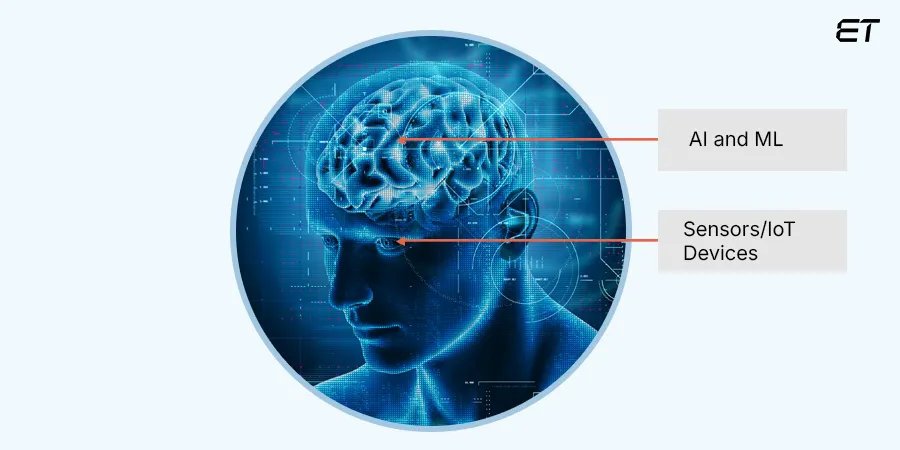
Ambient Intelligence (AmI) is an ecosystem where multiple technologies work together to create intelligent, responsive environments. In this section, you can explore the key components that power this technology.
1. Sensors and IoT Devices – The Eyes and Ears
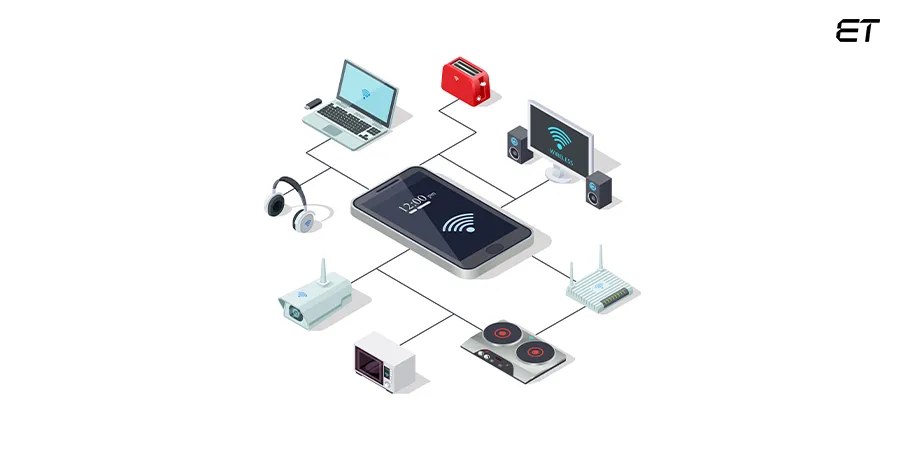
AmI begins with data collection. This is where sensors and IoT devices play a critical role.
Devices like motion sensors, cameras, wearables, and environmental monitors gather real-time data from the surroundings. Whether it’s detecting occupancy in a smart office, tracking a machine’s performance in a factory, or monitoring patient vitals in a hospital, sensors provide the raw input.
2. Artificial Intelligence (AI) and Machine Learning (ML) – The Brain
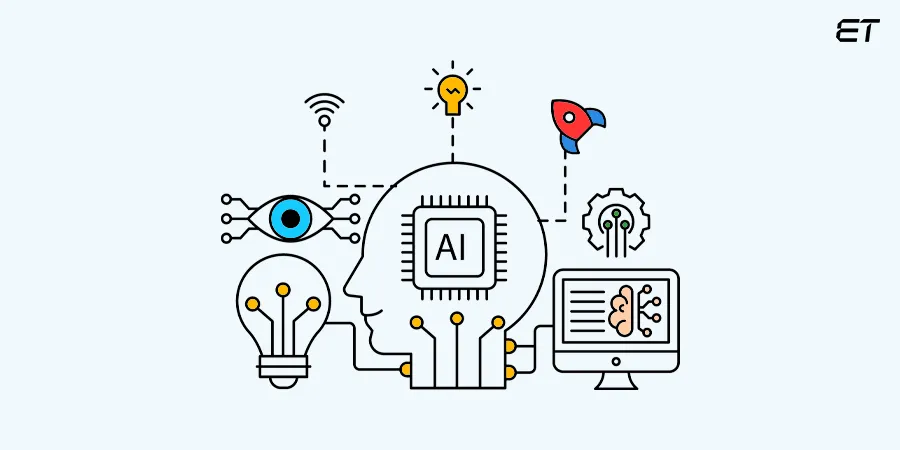
Once AmI collects the data, AI and ML algorithms step in to process and analyze it.
These models identify patterns, detect anomalies, and predict outcomes based on historical data. For example, a retail store’s AI-powered Ambient Intelligence system can analyze customer movements and adjust store layouts to optimize product placement for better sales.
3. Edge Computing – Real-Time Decision-Making
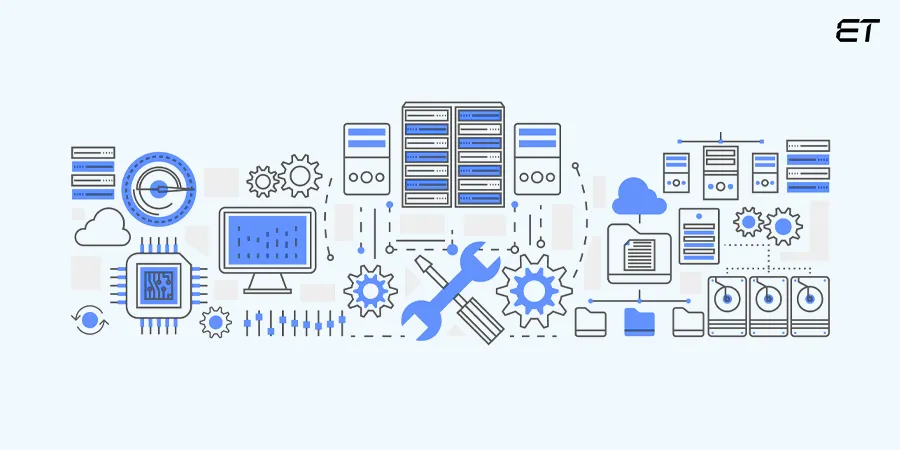
Instead of sending all data to a centralized cloud server, AmI leverages edge computing.
This way, it processes information closer to the source. Here, the source is right at the sensor or local device. Such an activity speeds up decision-making, reduces lag, and ensures instant responses. Think of a smart security system that can instantly flag an unauthorized person rather than waiting for cloud-based processing.
That’s a perfect example of Ambient Intelligence.
Wondering how much it costs to develop an artificial intelligence application?
4. Big Data Analytics – Extracting Meaningful Insights

AmI generates massive amounts of data. Without proper analysis, this information is just noise.
Big data analytics ensures that AmI doesn’t just react but learns and optimizes over time. It finds correlations in user behavior, workplace efficiency, or system performance leading to smarter automation.
5. Cloud Computing – The Backbone of Storage and Scalability

For AmI to operate efficiently at scale, it needs secure, flexible, and accessible data storage.
Cloud computing allows you to store, manage, and process large datasets. At the same time, you can also enable remote access through this technology. This component is useful for global organizations that need to deploy Ambient Intelligence systems across multiple locations.
6. Human-Centric Interfaces – Enabling Seamless Interaction

While AmI primarily works autonomously, it still needs human interaction in many cases.
Interfaces like voice assistants, gesture controls, biometric recognition, and augmented reality help users interact with intelligent environments effortlessly. For example, in smart homes, AmI-powered systems can adjust lighting and temperature by detecting a person’s presence or recognizing their voice commands.
7. Security and Privacy Mechanisms – Protecting Data and Compliance

With so much data flowing through an Ambient Intelligence system, security is non-negotiable.
These systems must include encryption, access controls, and compliance with GDPR regulations to protect sensitive data. If you decide to use AmI, it’s vital to implement robust cybersecurity measures to prevent data breaches and unauthorized access.
Industry Applications of Ambient Intelligence
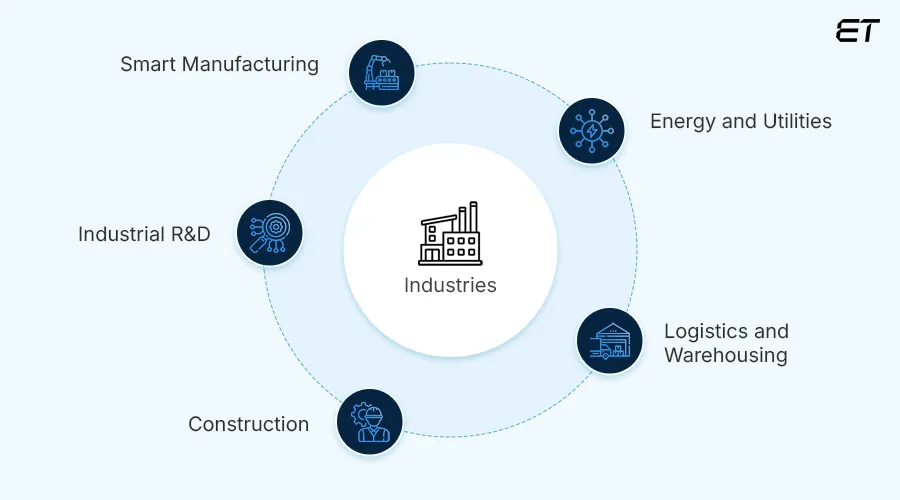
From predictive maintenance in factories to energy-efficient smart grids, AmI is unlocking new levels of automation. Let’s explore how it’s reshaping various industrial landscapes.
Smart Manufacturing
Major Scope: Predictive Maintenance and Process Automation
Traditional factories rely on scheduled maintenance. These activities cause unnecessary downtime or unexpected breakdowns. AmI changes enable real-time monitoring of machines and predicting failures before they happen.
Here’s how this technology works:
- Smart sensors track vibration, temperature, and performance anomalies in equipment.
- AI algorithms detect patterns indicating wear and tear.
- Automated alerts schedule maintenance only when needed, reducing downtime and costs.
Impact: Lower operational costs, extended machine lifespan, and uninterrupted production.
Energy and Utilities
Major Scope: Smart Grids and Efficiency Optimization
Energy industries are under pressure to reduce waste and improve efficiency. AmI helps power plants and grids become self-regulating and demand-responsive.
Here are some application areas and examples:
- Smart meters and sensors monitor energy consumption in real time.
- AI predicts demand fluctuations and adjusts power distribution automatically.
- Industrial plants optimize energy usage by adjusting systems based on occupancy and workload.
Impact: Reduced energy waste, lower carbon footprint, and optimized energy distribution.
Logistics and Warehousing
Major Scope: Intelligent Inventory and Autonomous Operations
Managing large-scale logistics is data-intensive and complex. AmI-powered warehouses ensure seamless inventory tracking, automated restocking, and optimized supply chains.
Ambient Intelligence works in the following ways:
- RFID tags and smart sensors track inventory movement in real-time.
- AI anticipates stock shortages or excess and automatically triggers restocking.
- Autonomous robots and drones streamline picking, packing, and shipment processes.
Impact: Faster deliveries, reduced storage costs, and minimal human error.
Construction and Infrastructure
Major Scope: Safety and Smart Site Management
Industrial construction sites are prone to hazards and inefficiencies. AmI enables real-time safety monitoring and resource optimization.
Here are some use cases of this interesting tech:
- Wearable sensors detect worker fatigue, hazardous gas leaks, or unsafe behavior.
- AI-powered surveillance spots potential structural weaknesses before failures occur.
- Smart construction materials adjust their properties based on environmental conditions (e.g., self-healing concrete).
Impact: Fewer accidents, reduced material waste, and improved project timelines.
Industrial R&D
Major Scope: Smart Product Development
Industrial R&D is leveraging AmI for faster, data-driven innovation. AI-assisted simulations and automated testing accelerate product development.
Here’s how this technology finds its utility:
- AI analyzes real-world usage data to refine product design.
- Smart labs automatically adjust testing conditions based on the experiment’s progress.
- Digital twins create virtual prototypes, reducing the need for physical testing.
Impact: Faster innovation cycles, reduced R&D costs, and market-ready products sooner.
Final Thoughts
It is safe to say that Ambient Intelligence is the future. The days of passive AI are fading. Reactive automation is slowly becoming the past. Now, you need to shift toward proactive, self-optimizing intelligence. AmI is a strategic advantage that can make your operations smarter, leaner, and future-proof.
From predicting failures before they happen to creating environments that adapt in real-time, this technology has tremendous potential. The question is no longer if businesses will adopt it, but how soon they can implement it to stay ahead.
So, if you want to explore how Ambient Intelligence can drive efficiency in your business, the time to act is now. Our experts can help you navigate the transition to intelligent, autonomous systems.
Fill out our NDA-proof form to book a fruitful meeting with our POC.
Frequently Asked Questions
1. How is Ambient Intelligence different from traditional AI?
Traditional AI processes data and executes tasks based on pre-set commands or prompts. In contrast, Ambient Intelligence (AmI) acts autonomously. This technology analyzes real-time data, detecting patterns, and making proactive decisions without waiting for human input.
2. What are the biggest challenges in adopting AmI?
Key challenges in adopting AmI include high implementation costs, integration with existing systems, data privacy concerns, and the need for advanced AI models to ensure accuracy and reliability.
3. Is Ambient Intelligence safe in terms of data privacy?
Yes, but only with robust security measures like encryption, access controls, and data protection laws (e.g., GDPR) compliance. Since AmI collects vast data, you must prioritize cybersecurity to prevent breaches.
4. How much investment does AmI require?
The costs vary based on the scale of implementation. Large enterprises may invest millions in full-scale innovative environments. At the same time, smaller businesses can start with modular solutions, integrating AmI gradually into their operations.






